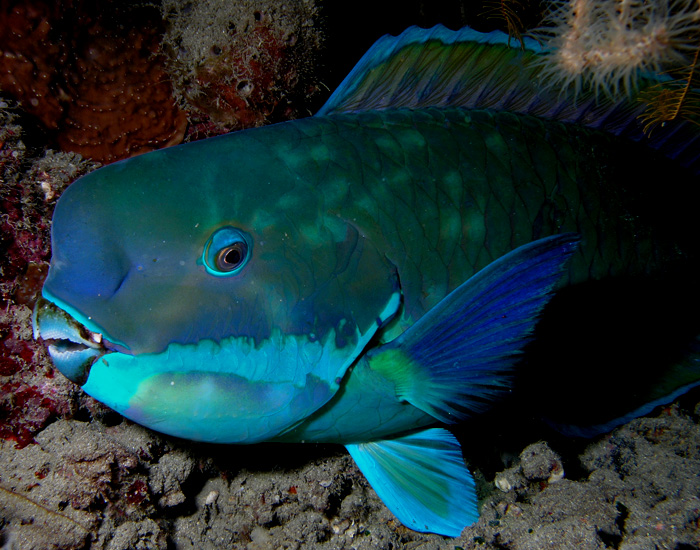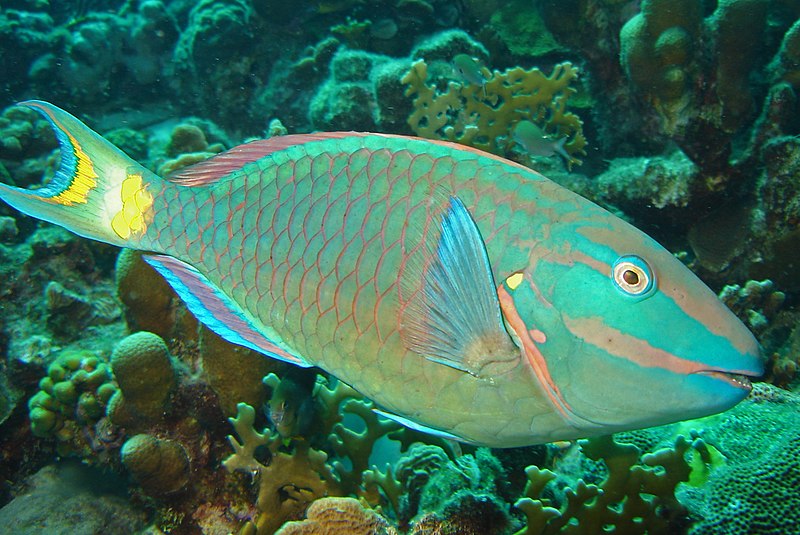| Jeez they look like a sad beauty pageant kick-off. |
Parrotfish are often recognized as one of the most beautiful groups of fish in the ocean. Many species hold striking colours that dazzle and amaze, and make other less-colourful species of reef fish look like garbage. Little do many know that the parrotfish possesses an array of dark, dirty secrets behind it's trying-too-hard-to-be-pretty visage. Much like the common emotionally-confused teenage girl.
 |
| What are you hiding... |
There are many different types of parrot fish, some with bizarre shapes and patterns and others that look like a melted clown. Roughly ninety species to be exact, belonging to the family Scaridae. However it's thought that parrotfish may actually be a subfamily of wrasses (which would make wrasses very sad). They can also be found inhabiting the subtropical shallows across the globe. While they mainly dwell in shallow reefs and rocky coves, parrotfish have been observed inhabiting harbors and marinas in schools to pluck out algae and small rocks to feed on. As you may have already guessed, the parrotfish looks almost indistinguishable from the parrot bird. Parrot birds were greatly offended by the comparison.
| Here is a picture of a one. |
One of the most characteristic features about the parrotfish is it's freakishly fused teeth, which form a sort of "beak" for crushing rocks and breaking coral polyps.
 |
| Wait that's not the right image. |
| That's more like it. |
They have evolved this feature because all the parrotfish really eats is algae and rocks. Because of that, parrotfish play a major role in preventing algae overgrowth in the reefs they live on. Too much algae could inhibit the coral to grow. Thus the parrotfish gracefully scrapes the edible algae off of rocky surfaces, which contributes to the process of marine bioerosion. Parrotfish also have a set of specialized teeth located in their throats called pharyngeal teeth, that are used for grinding rocks and coral skeletons.
| A set of pharyngeal teeth from a Bumphead parrotfish. |
The reason for these teeth is because the parrotfish feeds off of the succulent coral polyps that live inside of coral skeletons. More specifically the algae growing inside the polyps. After the algae is digested, the unwanted rock material is then pulverized and jettisoned out the fish's butt. As a fine sand.
To better understand this process, imagine yourself eating a sandwich made of rocks. But in the middle of these rocks was a delicious layer of ham. So you grind up and eat the entire sandwich. Then you go to the bathroom and simply- actually I don't think this is really helping.
This sand however plays an important role in the formation of beaches and islands. It becomes kicked up and grouped together in large masses. Over time it mixes with other ocean sediments, creating large formations and shorelines. Think about that next time you book a summer vacation.
| I know what you're thinking. |
Most species of parrotfish are naturally-born hermaphrodites. They are born female, and as they age develop into males. These are called the initial (female) and terminal (male) phases. Parrotfish in the initial phase are usually much more dull-coloured than those in the terminal phase. There are exceptions to this, however. For example, some female Mediterranean parrotfish don't change sex at all. The Stoplight parrotfish can be born either male or female. Those who are born directly as males often will have the colour patterns of the initial phase.
 |
| Here is a Stoplight parrotfish in it's boring less-flashy initial stage. |
 |
| And here is a picture of one in it's terminal phase. Can you imagine if people did this too? |
Remember, the next time you book a tropical island getaway, think of the parrotfish. Because it just crapped out that massive lump of half-digested sand that you call a beach paradise. You should be thanking them for their hard work.
| Oh will you get out of here. |
Sources:
en.wikipedia.org
www.seafocus.com
www.coexploration.org
www.sheddaquarium.org

No comments:
Post a Comment